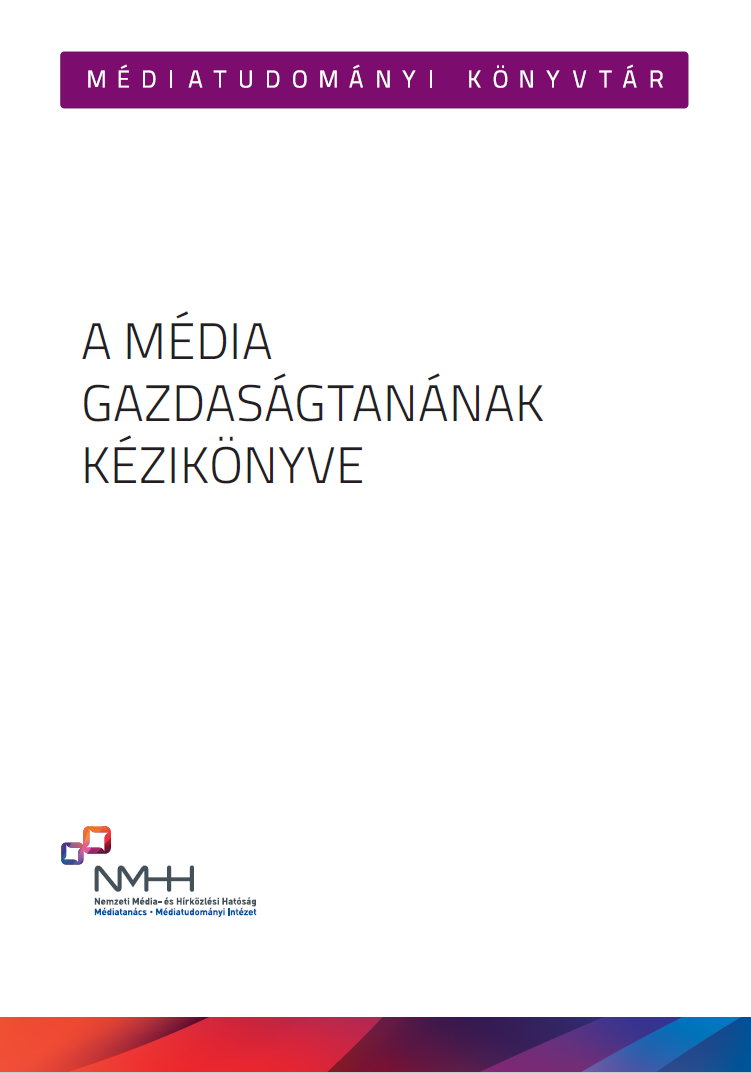Publikációk
Médiagazdaságtan kézikönyv
DMMD papers
Feltöltés alatt.
Konferencia-előadások
- Gálik Mihály (2017): A média átalakulása – a tömegmédiától a digitális hálózati médiáig. Digitális múlt és jövő – DMMD Konferencia, Budapesti Corvinus Egyetem, Budapest, 2017.11.08.
- Csordás Tamás (2018): Márkák és digitális felhasználói tartalmak kapcsolata: Az internetes mémek példája. Médiapiac 2018 – geneRÁCIÓk Konferencia, Budapest, 2018.03.22.
Vezetéstudomány „Digitális marketing” különszám (2018. december)
- Gáti, Mirkó, Mitev, Ariel, Bauer, András (2018): Can social media help salespeople in building customer relationships? In: Gounaris Spiros, Alexandr Matthew, Hamilton Kathy, Karampela Maria, Lacka Ewelina (szerk.) 47th EMAC Conference: People Make Marketing. Konferencia helye, ideje: Glasgow, Egyesült Királyság / Skócia, 2018.05.29-2018.06.01. Glasgow: University of Strathclyde, 2018. Paper online. (ISBN:978-1-5272-1911-3)
- Horváth, Dóra, Cosovan, Attila, Komár, Zita (2018): #Visual #Communication #Development: Visual Communication Project Integrated into the Educ ation of Future Economists In: Benedek András, Nyíri Kristóf (szerk.)8th Budapest Visual Leaning Conference: Communication – Culture – Consciousness: Abstracts. Konferencia helye, ideje: Budapest, Magyarország, 2018.04.26-2018.04.28. BME Műszaki Pedagógia Tanszék, p. 19. 3 p.
- Csordás Tamás, Horváth Dóra, Mitev Ariel, Markos-Kujbus Éva (2017): User-Generated Internet Memes as Advertising Vehicles: Visual Narratives as Special Consumer Information Sources and Consumer Tribe Integrators In: Siegert Gabriele, Rimscha M Bjørn, Grubenmann Stephanie (szerk.) Commercial Communication in the Digital Age: Information or Disinformation?. 270 p. Berlin: De Gruyter Verlag, 2017. pp. 247-266. (ISBN:9783110416794)
- Bauer, András, Horváth, Dóra, Mitev, Ariel (2017): The Role of Design and its Relationship to Marketing an Exploration In: Bijmolt Timmo, Koert van Ittersum, Peter Verhoef, Jaap Wieringa (szerk.) Leaving Footprints. 138 p. Konferencia helye, ideje: Groningen, Hollandia, 2017.05.23-2017.05.26. Groningen: University of Groningen, 2017. Paper online. (ISBN:978-90-367-9912-6)
- Horváth Dóra, Mitev Ariel (2017): Előszavak és előképek: Vendégszerkesztői előszövegezés Vezetéstudomány 48:(4) pp. 2-3.
- Gáti Mirkó, Mitev Ariel, Bauer András (2017): A közösségi média mindenek felett?: A technológiahasználat, valamint a közösségi média használatának hatása a vevőkapcsolati teljesítményre a személyes értékesítésben In: Bányai Edit, Lányi Beatrix, Törőcsik Mária (szerk.) Tükröződés, társtudományok, trendek, fogyasztás: Egyesület a Marketing Oktatásért és kutatásért (EMOK) XXIII. országos konferencia: Tanulmánykötet. 730 p.2017. pp. 300-309.(ISBN:978-963-429-1)
- Kenesei Zsófia (2017): Services in the digital era: How the role of customers changes with the adoption of new technologies. p. 1. 1 p.Románia, 3rd edition of the International Conference on Economics and Business Management (ICEBM); Kolozsvár, Babeş-Bolyai University, 2017. Október 27. (2017)
- Horváth, Dóra, Mitev, Ariel (2017): Voluntary Advertisers: Consumer Analysis Of Online Forum Comments Through Animal Metaphors In: Bijmolt Timmo, Koert van Ittersum, Peter Verhoef, Jaap Wieringa (szerk.) Leaving Footprints. 138 p.(ISBN:978-90-367-9912-6)
- Gáti, Mirkó, Mitev, Ariel, Bauer, András (2017): The effect of technology use and social media use on customer relationship performance in personal selling In: Florin Folrean, Udo Wagner, Călin Vegheș (szerk.) Bridging the Marketing Theory/Practice Gap and Competitiveness of New Europe. Konferencia helye, ideje: Temesvár, Románia, 2017.09.20-2017.09.22. Timisoara: West University of Timisoara, 2017. Paper online.(ISBN:978-973-125-580-4)
- Bauer András (szerk.) (2017): Digitális múlt és jövő. Konferenciakiadvány. Konferencia helye, ideje: Budapest,Magyarország, 2017.11.08 Budapest: BCE Marketing és Média Intézet, 2017. 12 p(ISBN:978-963-503-657-8)
- Gálik Mihály (2017): A média átalakulása – a tömegmédiától a digitális hálózati médiáig. In: Bauer András (szerk.) Digitális múlt és jövő. 12 p. (ISBN:978-963-503-657-8)
- Kenesei Zsófia (2017): Szolgáltatások a digitális világban: a vevő megváltozott szerepe az önkiszolgáló technológiák használata során In: Bauer András (szerk.) Digitális múlt és jövő. 12 p.(ISBN:978-963-503-657-8)
- Csordás Tamás (2017): Márkák és digitális felhasználói tartalmak kapcsolata: Az internetes mémek példája, In: Bauer András (szerk.)Digitális múlt és jövő. 12 p. (ISBN:978-963-503-657-8)
- Gáti Mirkó, Mitev Ariel, Bauer András (2017): A közösségi média hatása a személyes értékesítésre. In: Bauer András (szerk.)Digitális múlt és jövő. 12 p. (ISBN:978-963-503-657-8)
